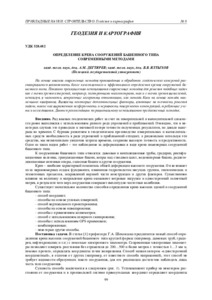Please use this identifier to cite or link to this item:
https://elib.psu.by/handle/123456789/7840Full metadata record
| DC Field | Value | Language |
|---|---|---|
| dc.contributor.author | Дегтярев, А. М. | - |
| dc.contributor.author | Ялтыхов, В. В. | - |
| dc.date.accessioned | 2014-11-20T06:36:12Z | - |
| dc.date.available | 2014-11-20T06:36:12Z | - |
| dc.date.issued | 2014 | - |
| dc.identifier.citation | Вестник Полоцкого государственного университета. Серия F. Строительство. Прикладные науки : научно-теоретический журнал. - 2014. - № 8. – С.99-105. | ru_RU |
| dc.identifier.issn | 2070-1683 | - |
| dc.identifier.uri | https://elib.psu.by/handle/123456789/7840 | - |
| dc.description | Definition of Tower Building Tilt with the Help of Modern Methods / А. Degtjarev, V. Jaltyhov | ru_RU |
| dc.description.abstract | На основе анализа современных методов производства и обработки геодезических измерений рассматривается возможность более качественного и эффективного определения кренов сооружений башенного типа. Показано преимущество использования современных методов для решения подобных задач как с точки зрения измерений, например, электронными тахеометрами, так и с точки зрения вычислений, используя, в частности, встроенные алгоритмы оптимизации, или метода Каса на основе метода наименьших квадратов. Выявлены некоторые дополнительные факторы, влияющие на точность решения задачи, такие как выраженная несферичность и неровность поверхности конструкций, требующие учета и исследования. Даются рекомендации по рациональному использованию предложенных методик.= Based on the analysis of the modern methods of carrying out and processing geodetic measurements, the article discusses the possibilities of more efficient definition of tower building tilt. The advantages of using up-to-date methods are demonstrated for solving these problems not only for measurement purposes, for instance, with the help of a total station, but also for data processing, for instance, with the help of the optimization procedure or Kasa method based on least square adjustment. The article reveals a few additional factors, which have impact on the results accuracy, such as expressed non-sphericity and unevenness of construction surface, requiring consideration and research. The author provides recommendations for the rational implementation of the suggested techniques. | ru_RU |
| dc.language.iso | ru | ru_RU |
| dc.publisher | Полоцкий государственный университет | ru_RU |
| dc.relation.ispartof | Веснік Полацкага дзяржаўнага ўніверсітэта. Серыя F, Будаўніцтва. Прыкладныя навукі | be_BE |
| dc.relation.ispartof | Herald of Polotsk State University. Series F, Civil engineering. Applied sciences | en_EN |
| dc.relation.ispartof | Вестник Полоцкого государственного университета. Серия F. Строительство. Прикладные науки | ru_RU |
| dc.relation.ispartofseries | Серия F. Строительство. Прикладные науки;2014. - № 8 | - |
| dc.rights | open access | ru_RU |
| dc.subject | Прикладная геодезия | ru_RU |
| dc.subject | геодезические измерения | ru_RU |
| dc.subject | крен башенных сооружений | ru_RU |
| dc.title | Определение крена сооружений башенного типа современными методами | ru_RU |
| dc.type | Article | ru_RU |
| dc.identifier.udc | 528.48 | - |
| Appears in Collections: | 2014, № 8 | |
Files in This Item:
| File | Description | Size | Format | |
|---|---|---|---|---|
| 99-105.pdf | 234.82 kB | Adobe PDF |  View/Open |
Items in DSpace are protected by copyright, with all rights reserved, unless otherwise indicated.